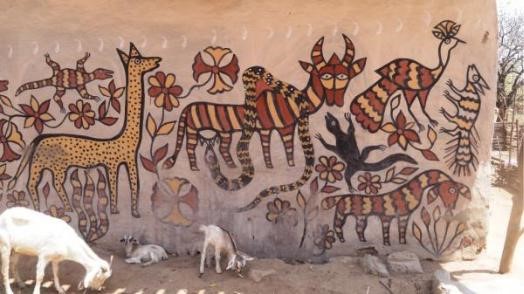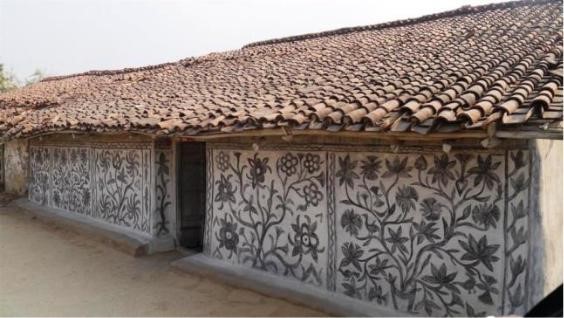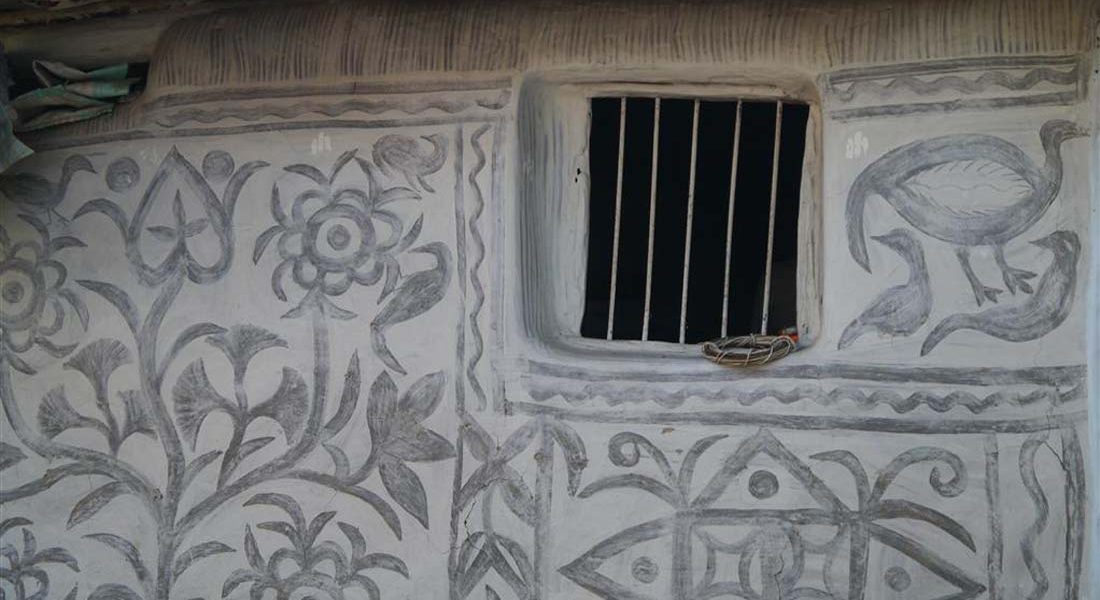
Justin Alka Imam, Secretary, Virasat Trust, Hazaribagh, Jharkhand. Life member of INTACH. Promoter of Tribal and folk arts. Worked extensively on Khovar and Sohrai art.
—
Background I Read the Pdf version | Khovar and Sohrai paintings
In 1991 the Isco rock art (10,000, B.C) shelter was brought to light by Bulu Imam, Convenor INTACH Hazaribagh Chapter and subsequently during frequent visits to the Isco site in Barkagaon block 50 kms south west of Hazaribagh, the villages of Kharati, Badhuli Pipradhi and Jorakath inhabited by Prajapati (potters) and Kurmi (farmer) communities revealed a mural marriage art tradition known as Khovar, a name used to refer to the prehistoric rock art site of Isco. In 1992 late Jason Imam found another village namely Bhelwara in Bishungarh block with a mural tradition done for the Sohrai harvest festival one day after Diwali (festival of lights) in the winter months of Oct-Nov.
In 1993, the Australian High Commission New Delhi under its DAP Grant funded INTACH to bring the Khovar and Sohrai mural art on to paper using glue-paper technology provided by Dr. Erwin Neumayer (Rock art expert) from Vienna, Austria. Hence, during 1993-94 and 1994-95, INTACH Hazaribagh Chapter nurtured over seventy traditional women artists from the above four villages, who successfully transferred the mural comb-cut (scraping) Khovar art onto handmade paper, resulting in the formation of the Tribal Women Artists Cooperative (TWAC). It was soon to draw the attention of the Art curators from Australia who visited Hazaribagh and took back works for exhibitions in major cities in Australia from 1995 onwards. (see list of exhibition). In 2000 the Australian Museum, Sydney invited three traditional women artists to paint live demonstration murals in large size on boards and canvas which went into major collections.
The Khovar and Sohrai art traveled to Europe (UK, Germany, France) and Canada from 2001 through a number of exhibitions which continued for a decade. In 2008, The National Museum of Italy Pigorini, Rome invited three traditional women artists of TWAC, who painted large murals on canvas and the exhibition continued for several months. INTACH & TWAC continued to have exhibitions the following years. In 2019 three traditional women artists of TWAC were invited by the National Gallery of Canada to paint large 8×20 feet murals on canvas for the Akakhona Indigenous Art Exhibition which continues throughout 2000.
However, the Sohrai – Khovar art promotion through international exhibition brought much global recognition, but there was a need to highlight the art tradition at a regional and national level. Henceforth, In 2008, VIRASAT Trust was founded by Justin & Alka Imam to nurture and encourage the other remaining traditional Khovar and Sohrai women artists who were only known through paintings and exhibitions. VIRASAT Trust’s objective was to protect, preserve and promote the Khovar – Sohrai women artists. Henceforth, in 2008, the Bhagwan Birsa Biological Park in Ormanjhi, Ranchi was painted with 17,500 Sq ft of boundary wall with Khovar and Sohrai murals by 21 traditional women artists from Hazaribagh, funded by the Department of Tourism (Govt. of Jharkhand).
This was the first occasion when the village women artists were provided the opportunity to go outside their homes to urban cities for painting murals. Subsequently, VIRASAT Trust undertook several initiatives to provide traditional women artists to demonstrate their art visiting to paint the Durga puja pandal in New Alipore Kolkatta (2008), Army War Memorial, Ranchi. In 2011 VIRASAT trust had its first major exhibition at the Cymroza Art Gallery, Mumbai and started to make traditional women artists participate in Regional and National Art Camps.
In 2014 six traditional women artists participated in the Crafts Council of West Bengal & EZCC Art Camp at Shantiniketan, West Bengal. In the winter of 2014, we were visited by Deidi Von Schawen (photographer) from Paris, France who visited the traditional villages and we shared the concern of the lessening of the mural art tradition in the villages, and the urgent need to revive the art tradition of annual mural paintings on mud house walls using natural earth colours. This resulted in the formation of Femmes du Hazaribagh an Association founded by Deidi Von Schawen to raise funds to provide earth colours and reward incentives to the traditional women artists to continue the mural painting tradition.
VIRASAT was entrusted to identify several other villages namely – Oriya, Ango (Churchu block), nano (Daru block), Lukiya, Purnapani and Jarwadhi (Tatijharia block), Daujinagar-Jihu (Padma block), Saheda, Isco, Jorakath, Kharati (Barkagaon block) and Bhelwara (Bishungarh block) where red oxide and yellow oxide earth colors were provided to the women artists and every household which got painted the women artists were rewarded with wall clocks, sarees and blankets.
In 2015 we started with 70 women artists and in 2016 increased to 160 women artists, in 2017 nearly 250 women artists participated and in 2018 the number increased to 360 women artists. This year we were visited by an elderly Japanese couple Jinchi Kuramare and his wife Kyoko who visited all the villages and produced a beautiful photobook titled – Tribal Art in India and conducted three major exhibitions of Khovar-Sohrai paintings in Tokyo (Japan).
In 2015, six traditional women artists participated in the Lalit kala Akademi, National Tribal & Folk Art Camp in Bhopal. The same year (2015), the Hazaribagh Railway station was newly constructed and the entire platform and reception area was painted with Khovar and Sohrai paintings by 20 traditional women artists through VIRASAT Trust. This drew the attention of the Honorable Prime Minister of India Shri. Narendra Modi who visited to inaugurate the Hazaribagh railway station, and he praised the efforts of the women artists in his National radio talk “Maan ki Baat”. This mention went viral and drew the concern of the Hazaribagh District Administration and the then Chief Minister of Jharkhand Shri, Raghubir Das, who issued an official circular that all Government boundary walls and prominent buildings to be painted with Sohrai-Khovar art.
The city of Hazaribagh and Ranchi and several major Districts of Jharkhand were subsequently painted with Sohrai-Khovar murals by traditional women artists who were financially benefited and got the opportunity to demonstrate their art raising their pride & self-esteem.
In 2016, the Bhagwan Birsa Munda Biological Park at Ormanjhi Ranchi was re-panted with Sohrai-Khovar mural art covering an area of 18,500 sq/ft by 20 traditional women artists. Subsequently in 2017, VIRASAT trust made an installation of a maati-ghar decorated with Sohrai-Khovar art in the departure terminal of the Bhagwan Birsa Munda Airport in Ranchi and the Arrival wash room and escalator area of the airport. The Sohrai-Khovar murals in interior of Hazaribagh Circuit house, Sadar hospital and other buildings were also initiated by the District Administration.
In 2018, VIRASAT trust had a major exhibition of Khovar-Sohrai paintings and live demonstration by traditional women artists at the India international Centre Kamladevi Chatopadhya art Gallery, New Delhi which was very well received and reviewed.
In 2019, VIRASAT trust Coordinated a major Sohrai-Khovar mural paintings project at the Asian Heritage Foundation (Rajeev Sethi) office, museum exterior walls of the building located at T-112 Aam bagh, Mehruli, Delhi. Nearly 100 cement boards (4x8feet) were painted by a team of six traditional women artists over a period of 90 days covering four months. They were assisted by Art designers, carpenters and consultants through JIYO program funded by the World Bank to exhibit traditional arts in Urban space and architectural ambiance.
In 2019, the Hazaribagh District Administration assisted us in the formation of the Sohrai Kala Mahila Vikas Sahyog Samiti Ltd. Under the Cooperative Act 1935 with over 260 traditional women artists from ten villages to initiate our proposal for the Geographical Indicator status tagging through GOI, registration process via Dwaka and Chennai IPR HQ to get recognition and identity to the SOHRAI- KHOVAR ART of Jharkhand. After a decade of activities initiated by VIRASAT Trust, the fruit of our relentless devotion for the nurturing of the women artists and the Sohrai-Khovar art was established.
In 2020, We conducted a mural painting in the World Spa (Card room East wing) in Gurgaon with two traditional artists Putli Devi and Malo Devi who painted the Sohrai art and comb-cut Khovar art,15-26th Jan 2020. Then we conducted live-art demonstration and exhibition at Natrani, Malvika Sababai Art Centre, Ahmedabad 29 Jan to 2nd Feb 2020 with two traditional women artists. Then, we conducted an exhibition of Sohrai- Khovar paintings on canvas & handmade paper along with Art interventions on Carpets and Rugs with Sohrai-Khovar motifs by Shraddha Mehta and textile prints on Kaddi, Tassar silk and cotton Stoll’s by Ashish Satyavarth Sahu at the IGNCA Art Gallery, New Delhi 24-28 Feb 2020 , which was inaugurated by the Director General of NGMA Delhi, and continued the same exhibition at the Gallery Art Life Noida 8-21 March inaugurated by Padma Shri. Ram Sutar (Sculptor) with Live Art demonstration by two traditional women artists.
For our efforts Justin Imam was awarded the prestigious CV Subramaniam Award from National Foundation of India (Delhi) for the Voluntary Community sector Leadership. On 13th May Sohrai- Khovar Art was recognized by GOI and given Jharkhand State’s first Geographical Indicator Status tag from the Registrar of Geographical Indicator, Chennai.
Harvest (Sohrai) and marriage (Khovar) murals of Hazaribagh
Hazaribagh is the headquarter of the North Chotanagpur Division located on a plateau with the leafy township of middle size surrounded by a number of picturesque forest villages hamlet in hills and valley. The Hazaribagh and adjoining Chatra district have revealed nearly 18 pre-historic rockart sites dated to the Mesol-Chalcolithic period (10,000 B.C) in the Sati, Maudhi and Satpahar hills in the North Karanpura valley, drained by the river Damodar flowing west to east. These painted rock-art shelters referred to by local tribals as “Khovar” meaning Caves of the bridal couple were first brought to light by Bulu Imam (Convenor INTACH Hazaribagh in 1991 and subsequent explorations by his family uncovered the vast wealth of Palaeolithic, Mesolithic, Neolithic, Chalcolithic, Iron age, Megalithic burial grounds, Buddhist sites (9-12th Century A.D) co-existing amidst tribal village communities belonging to Munda, Santal, Oraon, Agaria, Birhor and Kurmi, Prajapati, Ghatwal, Ganju, and other artisanal guilds who carry the mural painting tradition of decorating their clay mud house walls for festivals and marriage ceremonies.
The village paintings are considered auspicious symbols related to fertility and prosperity being painted on the walls. There are two major stylistic divisions based on the marriage and harvest seasons, and four major painting techniques- scraping with four finger, scraping with broken pieces of combs, twig-brush and cloth swab stencil or glyptic paintings.
Khovar (Kho is caveand Vara bridal couple) is a marriage mural art of the tribaland Scheduled castes communities of Hazaribagh (Jharkhand) found throughout the plateau, living in forested hill villages, and agricultural valleys. Khovar or the Comb-Cut art done during the marriage season, a type of sagraffito art using Reversed Slip pottery technique. This technique consists of applying a ground base-coat of manganese black earth Ochre and letting it dry, after which a wet slip of kaolin creamy white earth colour is applied and cut or scraped off in various designs or motifs with a plastic or bamboo comb, or with the four fingers of the hand. The under layer is of a stark contrast with the upper layer, usually black and white.
The monsoon brings harvest. After the monsoons have washed the mud house walls bare, which need repair, re-plastering, repainting of these traditional village houses with natural earth ochre colours, and worship of cattle as a ritual thanks giving for a good harvest celebrated with the Sohrai art. The traditional term Soh/Soro means to drive away and rai is a stick, denoting the early domestication of animals for agriculture and accumulation of wealth. Both Khovar and Sohrai are ancient words carrying traditional significance enacted in ritual paintings done only by tribal and traditional women artists.
Sohrai is the winter harvest art, and is celebrated one day after Diwali (festival of light). The Sohrai murals depicting Pashupati (lord of animals), Kamla baan (forest of lotuses), and Tree of Life, is painted using cloth swabs or chewed twigs of the local Saal forest tree used for brushing their teeth (called datwan) by the villagers. Many of the designs may be compared with prehistoric rock art and pottery markings and prehistoric seal motifs from Harappa.
Sohrai is distinguished to mark the first domestication of cattle and the birth of agriculture in Jharkhand. Sohrai painting is done every year after the heavy Indian monsoon has washed away the painted walls and when the paddy fields are ready to be harvested! Sohrai coincides with the festival of Diwali during the early winter months and celebrated by almost all tribal and agricultural communities like Oraon, Munda, Santal, Agaria, Ganju, Kurmi, Ghatwal, etc. One could drive through the Saal (Shorea robusta) forests to see low houses with mud wall and clay tiled roofs beautifully painted with oche earth colour found locally.
All houses are painted in a unique style using natural red, (haematite red oxide) found in the hilly tracts in ore form that is grinded or the morhum gravel used for paving countryside forest roads is washed to obtain the terracotta red colour; while the creamy white (Kaolin) is dug out from riverine nallas or streams, while the black colour (manganese ochre) is dug out from hilly streams or collected from sacred deposits on the banks of the hilly rivers and yellow earth ochres colour is found in ore form of riverine pebbles.. Women artists paint animals and birds, lotuses, elephants and tigers, sacred motifs, etc. giving a colourful surprise hidden in forest and rural landscape. Sohrai art is a Parampara tradition carried on and taught from generation to generation by women artists.
The Sohrai and Khovar art has been widely exhibited through Tribal Women’s Artists Cooperative (TWAC), and VIRASAT Trust since 1995 in Australia, Europe, UK, USA, and India with over seventy international and exhibitions. The commercially printed Khovar collection brought onto Wall paper and textile fabric by L`Aviva home (USA) has added to the diversity in the art idiom.
The nurturing of traditional village mud house murals painting of Khovar and Sohrai art has been motivated with revival and resurgence, made possible by support from photographer Deidi Von de Schawen’s French Association Femmes du Hazaribagh (Paris) and Department of Tourism, Art & Culture (Govt. of Jharkhand), Hazaribagh District Administration coordinated by VIRASAT Trust, who have been distributing earth colours (red oxide, yellow ochre, manganese black and Kaoline white) to village artists and motivating the traditional art to be continued with gift incentives of wall clocks, Sarees and blankets to each house which is painted. The Sohrai and Khovar village murals can be seen in nearly 13 villages of the Hazaribagh district of north Jharkhand state namely – Bhelwara (Bishungarh block), Lukiya, Jarwadhi, Purnapani, (Tatijharia block); Oriya, Ango, (Churchu block); Nano (Daru block) Jorakath, Isco, Saheda, Kharati (Barkagaon Block),and Daujinagar (Padma block) with over 300 traditional and tribal women artists.
JORAKATH
the Jorakath village near Charhi, in the Sati hills amidst Saal forest with nearly a hundred households that exhibit the Sohrai harvest murals using broken pieces of combs. After the monsoon has washed and weathered the mud house walls, in the months of October-November, the women artists repair and re-plaster the clay walls, courtyards, and rooms with cow dung, husk and earth, after which they apply the liquid manganese black kali maati, which is let to dry and the following day they coat these walls with liquid kaolin creamy white dudhi maati which is applied with cloth swabs and scrapped off with broken pieces of combs to reveal the motifs in dark black etchings, depicting the forest animals, birds, plants, flowers, fishes and symbols. The Kurmi agricultural community of the Jorakath village, along with their neighboring Ganju community have mud homes which house cattle and poultry within the living space, and the murals are done everywhere from the floor to the ceiling.

ORIYO-ANGO
The Oriya and Ango villages paint murals with the glyptic painted murals of village homes using kaolin creamy white clay obtained from forest streams, hematite red-oxide iron-ore, and manganese black earth colour found in the hills. The Sohrai harvest murals are a feast for the eyes revealing labour of love done by traditional women artists after repairing, re-plastering and painting the village mud house walls with cloth swabs daubed in liquid earth colours sometimes taking two weeks to paint the entire household, and courtyards.

BHELWARA
The Bhelwara village famous for the linear Sohrai painted murals using datwan (chewed Saal twigs) or brushes to draw motifs in lines of white, red and black symbolic of ancestors, life and death depicting “Pashupati” lord of animals seen ridding on the back of a bull, and “Kamlaban” Tree of life.

LUKIYA-JARWADHI
Close by are the Sathal tribal villages at Lukiya, Jarwadhi, and Purnapani exhibiting the graphic patterns of zig-zag, triangles and bold motifs painted for the Sohrai harvest festival is a visual delight of traditional mural art and architecture in forest hamlets.

DAUJINAGAR-JIHU
The Daujinagar – Jihu tribal Agaria Sohrai harvest murals are painted with cloth swabs daubed in the three earth colors (kaolin creamy white, Manganese black and hematite red) on the small mud houses with clay tiled roof.

SAHEDA
Ganju painting has its own distinctive wild and domestic animal forms, and unique jungle plant forms. During the harvest as well as the marriage season they decorate their houses with beautiful large murals of jungle animals and birds, and exotic plant forms, as if bringing the forest indoors. It is a quality which is most enduring. The Ganju houses at Saheda are painted with the forms of wild and domestic animals and birds forms like peacocks, elephant, tiger, crocodile, snake, jackal, plants, etc.

KHARATI – BARKAGAON
The tradition of comb cut/ scrapped painting is to be found exclusively in the Barkagaon valley in Kharati, Barwadi punkree, Bhadul-Pipradih, Nayatand, Napo, Barhmaniya. Most of the villages are predominantly an agricultural community, but also an artisanal guilds such as Prajapati or potter, Rana or carpenter, Teli or oil extractors, Turi or basket makers and bamboo workers, and the wandering groups such as the Malhar metal-casters also paint
elaborate murals.

ISCO
The village of Isco adjoin the rock-art (10,000 B.C) sites in the Sati hills where the Munda tribal women paint the similar pre-historic designs on the house walls giving it a symbiosis with the art. The Munda paint or scrape with their fingers in the soft-wet earth of their houses, using unique motifs such as the rainbow snake (Lorbung) and plant forms of a deity similar to the Prajapatis and Kurmis. They commonly spot their painting with vermilion and white dots. First the designs are cut in mud clay and then filled in with white markings, and vermillion. The designs are generally plant forms.

–
© Copyright by author
First published: 22 August 2020
Other links:
भोजपुरी अंचल (पूर्वांचल) के कोहबर चित्र का वैशिष्टय
Documenting the Image in Mithila Art
Maithil Paintings: An Enquiry into Its Historiographical Trajectory (1947 -1997)
Madhubani Painting: A Historical Context
मिथिला चित्रकला का ‘लोक’ और उसकी प्रवृत्तियां
Disclaimer:
The opinions expressed within this article or in any link are the personal opinions of the author. The facts and opinions appearing in the article do not reflect the views of Folkartopedia and Folkartopedia does not assume any responsibility or liability for the same.
Folkartopedia welcomes your support, suggestions and feedback.
If you find any factual mistake, please report to us with a genuine correction. Thank you.
—
Tags: Khovar painting, Sohrai Painting, Tribal art, Rock art, Hazaribagh, ICH Jharkhand

